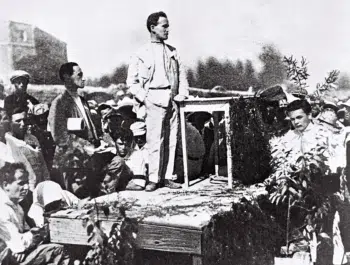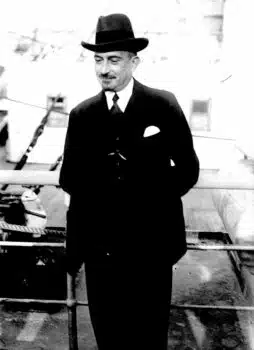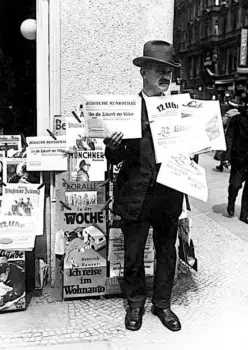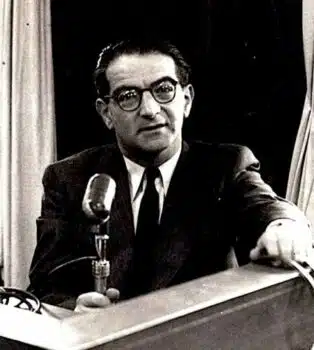A s uncomfortable as it may be to many, Israel’s current apartheid policies took shape in the lead up to the Holocaust when Nazi Germany and a small group of influential Zionists formed an alliance to build their ethno-nationalist states.

The cover of a matchbook distributed by the Non-Sectarian Anti-Nazi League to champion the anti-Nazi boycott of 1933. (Ephemeral New York, Wikimedia Commons, Public domain)
On Aug. 25, 1933, German Zionists signed an agreement with the Nazi government that allowed some wealthy German Jews to immigrate to Palestine in exchange for purchasing German goods that were then exported to the Jewish community in Palestine.
As part of the deal, the Zionists also agreed to lobby the global Jewish community to end their boycott of German goods that began when Hitler came to power.
A 1933 memo from the Zionist Federation of Germany to the Nazi party promised:
should the Germans accept the cooperation of the Zionists, these (sic) would try to dissuade Jews abroad from supporting the anti-German boycott.
The so-called Transfer or Haavara Agreement (named for the Tel Aviv company where the funds were transferred) was endorsed by top Nazi officials including Adolph Eichmann and Hitler and future Israeli prime ministers David Ben Gurion, Moshe Shertok and Golda Meir.
For the Zionists, the deal allowed affluent German Jews to keep some of their capital and resettle in Palestine. For the Nazis, the agreement not only helped rid Germany of a small portion of its Jewish population (60,000 between 1933-1939) but, critically, it doomed the boycott movement to failure and opened up the global export market for German goods to boost its economy.
For the majority of mostly non- and anti-Zionist Jews around the world, it was a betrayal that deprived them of one of the few weapons they had to fight the Nazis.
It was symbolised by the freakish image of the Haavara transport ship, the Tel Aviv, with its name inscribed in Hebrew on the bow, and the Swastika flag hoisted on deck.

Ben Gurion speaking at the cornerstone laying ceremony for the trade-union Histadrut building in Jerusalem, 1924. (National Photo Collection of Israel, Wikimedia Commons, Public domain)
In the decades before the agreement, Zionists’ efforts to build a Jewish state in Palestine had been slow. Even after the 1917 Balfour Declaration, which promised a Jewish homeland in Palestine, British authorities limited Jewish immigration and Jews found it difficult to acquire enough land to displace the indigenous Arab population. By 1920, Jews had only been able to purchase less than 2 percent of Palestinian land.
For the Zionists, Hitler’s ascendance presented a once-in-a-lifetime opportunity to supercharge immigration to Palestine: Israel’s future leader, David Ben Gurion, said “what Zionist propaganda for years could not do, disaster has done overnight.”
And according to German-Jewish journalist and historian Hannah Arendt,
anti-Semitism was an overwhelming force, and the Jews would either have to make use of it or be swallowed up by it. In expert hands [such as David Ben-Gurion & Co .] this ‘propelling force’…would be used in the same way that boiling water is used to produce steam power.
Who Should Be Saved
What was left out of the Zionist project, however, was the fate of the vast majority of European Jews who were being marginalized, attacked and murdered.
In his history of the British Mandate, One Palestine Complete, Israeli journalist Tom Segey wrote that “saving European Jews did not figure at the head of the priorities of the [Zionist] ruling class.” Rather, “the foundation of the State was primordial in their eyes.”
At a Zionist Labor Party conference in 1938, Ben Gurion laid out his formula for who should be saved after Britain’s offer to rescue thousands of Jewish children from Europe:
If I knew it was possible to save all the children in Germany by taking them to England, and only half of the children by taking them to Eretz Israel, I would choose the second solution. For we must take into account not only the lives of these children but the historic interest of the people of Israel.

Chaim Weizmann in 1900. (Bain News Service, Library of Congress, Wikimedia Commons, Public domain)
However, it wasn’t just any children the Zionists wanted in Palestine, such as the majority from the impoverished shtetls of Eastern Europe and Russia.
“We want only the best of Jewish youth to come to us…only the educated to enter,” declared Israel’s future president Chaim Weizmann at the 1937 World Zionist Conference in Zurich, Switzerland,
the other Jews will have to stay where they are and face whatever fate awaits them. These millions of Jews are dust on the wheels of history and they may have to be blown away. We don’t want them pouring into Palestine. We don’t want Tel Aviv to become another low-grade ghetto.
Indeed, the Zionists and Nazis were kindred spirits: both were building ethno-nationalist states premised on racial purity — a concept increasingly espoused at the time–and both vehemently opposed the assimilation of Jews in Europe.
“The attitude of the Zionists towards the encroaching menace of fascist domination in Germany was determined by some common ideological assumptions:” writes German journalist Klaus Polkhen in The Secret Contacts:
The fascists as well as the Zionists believed in unscientific racial theories, and both met on the same ground in their beliefs in such mystical generalizations as ‘national character (Volkstum)… and ‘racial exclusiveness.’
Seeing Eye-to-Eye With Fascists
A memo to the Nazi party from the Zionist Federation of Germany on June 21, 1933, assured the fascists that they saw eye to eye:
Our recognition of the Jewish nationality allows us to establish clear and sincere relations with the German people and its national and racial realities… because we too are against mixed marriages and for the maintaining of the purity of the Jewish group.

Street seller of Jüdische Rundschau in 1934 in Berlin. (Bundesarchiv, Wikimedia Commons, CC-BY-SA 3.0)
Athur Ruppin, a sociologist who headed the Palestine Zionist Executive, drew directly on Nazi master race theories.
He believed that Zionism required “racial purity” and that “only the racially pure come to the land.” Inspired by the work of Nazi scientists, he performed skull measurements to demonstrate that Ashkenazi Jews were superior to Yemeni Jews and argued against immigration of Ethiopian Jews because of their lack of “blood connection.”
In fact, some Zionists were elated by Nazi anti-Semitism. At a 1937 Berlin meeting with Adolf Eichmann, Feivel Polkes, a member of the Zionist underground army, commended the terror in Germany:
Nationalist Jewish circles expressed their great joy over the radical German policy towards the Jews, as this policy would increase the Jewish population in Palestine so that one can reckon with a Jewish majority in Palestine over the Arabs.
Polkes’s admiration was reciprocated by Eichmann, who claimed,
had I been a Jew, I would have been a fanatical Zionist. In fact, I would have been the most ardent Zionist there was.
Given their similar views on race and nation-building, the Nazis gave the Zionists preferential treatment in almost every sphere. They were the only non-Nazi group allowed to wear their own uniforms, fly their own flag and espouse a separate political philosophy up to 1939.
While the German Ministry of Propaganda banned all newspapers published by the Communists, Social Democrats, trade unions and other progressive organizations, the Zionist paper, the Judische Rundschau, was allowed to publish its propaganda unhindered from 1933 to 1939.
Unlike the German Zionists, most Jews in Europe were resisting the fascists–fighting them in Spain–where 30 percent of the American Lincoln Brigade were Jews–and in Poland, where half of the 5,000 Dombrovski brigade fighters were Jewish, smuggling arms to Eastern European ghettos and pushing for other countries to come to their rescue.
At the same time, Zionists were doing everything possible to scuttle these efforts.
In 1938, when a global conference of 32 countries convened in Evian-les-Baines, France, to address the issue of German and Austrian Jews fleeing Nazi persecution, only the Dominican Republic came to their rescue, offering up to 100,000 Jewish refugees “vacant areas of fertile land, excellent roads, and a police force that maintains law and order.”
Despite the generous offer, “the Zionists’ hostility was naked and uncompromising,” wrote Holocaust researcher S. B. Beit Zvi.
Zionists were resistant to anything liable to jeopardize their fundraising revenues…. If the Jews of America contributed to the colony in the Dominican Republic, they might give less to the Jewish National Fund or the Keren Hayesod [United Israel Appeal].
Similarly, Zionists were hostile to various other proposals and offers to resettle Jews in Australia, the Soviet Union, Japan, Madagascar and Alaska.
“Focusing on Palestine as the ONLY legitimate destination for large-scale emigration, the World Zionist Organization rejected opportunities from 1933 onwards to resettle German Jews in havens or homes other than Eretz Yisrael,” wrote American historian Edwin Black: “The Zionist stance made it clear: Palestine or nothing.”
Even by 1943 when the Holocaust was well underway, Zionists continued to block Jews who tried to settle outside of Palestine.
When a large group of American orthodox rabbis marched in Washington, D.C., asking President Franklin Delano Roosevelt to rescue Europe’s Jews, Zionist leaders dissuaded the president from meeting with them.
Playing to American anti-Semitism, the head of the World Jewish Congress, Rabbi Stephen Wise, and Samuel Rosenman, from the American Jewish Committee, told Roosevelt that the protesting rabbis were first-generation immigrants who were “not representative of American Jewry” and not the kind of Jews with whom Roosevelt should meet. Indeed, when they arrived at the White House, they were told (untruthfully) that Roosevelt was not available.
Later in 1941, when the U.S. Congress finally proposed forming a rescue commission, Rabbi Wise came to Washington to testify against the bill because it did not mention Palestine.
The Kastner Train

Kastner in the early 1950s at Kol Yisrael, the official Israeli state radio station, where he hosted a program in Hungarian. (Wikimedia Commons, Public domain)
Perhaps no other incident exemplified the Zionist betrayal more than the saga of the Kastner Train, which involved collaborating with Nazis over the fate of Hungarian Jews.
In April 1944, at the height of the exterminations, Adolf Eichmann offered a deal to Joel Brand, the head of the Hungarian Aid and Rescue Committee: the Nazis would spare the lives of one million Hungarian Jews in exchange for 10,000 trucks and other goods from the Allies.
Brand immediately flew to Istanbul to present the proposal to the Jewish Agency which, as Brand later said, lacked any sense of urgency, since it was more focused on Jewish emigration to Palestine than the slaughter in Europe.
Back in Budapest, Eichmann proposed another deal to Zionist leader Rudolph Kastner, Brand’s colleague from the Committee: in exchange for $1,000 each ($25,000 in today’s currency) Eichmann would allow the departure of 1,684 mostly affluent Jews, including Kastner’s family and friends, to escape to Switzerland by train. As part of the arrangement, Kastner agreed to not inform Hungarian Jews that they were being sent to their deaths in the crematoriums.
Between May and July 1944, 437,000 Jews–almost the entire rural Jewish population of Hungary were deported to Auschwitz, where most were gassed on arrival.
In 1954, an Israeli judge ruled that Kastner had “sold his soul to the devil” by negotiating with Eichmann to save some Jews, while “paving the way for the murder of Hungarian Jewry.” He was assassinated on 15 March, 1957. by members of the Lehi, Israel’s right-wing militia, for collaborating with Nazis. Kastner was later rehabilitated as a hero in Israel.
Many still maintain that the Haavara Agreement and Kastner’s deal with Eichmann were pragmatic decisions to save the lives of thousands of Jews and help build a Jewish homeland. But, as American journalist Lenni Brenner wrote about Haavara,
All excuses that it saved lives must be strictly excluded from serious consideration… it saved wealth, not lives… or, more properly, a piece of the property of the German Jewish bourgeoisie.
In the end, collaboration with the Nazis by a small group of Zionists broke the global boycott against Germany, weakened anti-fascist resistance worldwide, and contributed to the genocide of Europe’s Jews.
Indeed, the Zionists-Nazi Alliance became part of the ideological foundation of Israel’s apartheid and genocidal policies today.
Stefan Moore is an American-Australian documentary filmmaker whose films have received four Emmys and numerous other awards. In New York he was a series producer for WNET and a producer for the prime-time CBS News magazine program 48 HOURS. In the U.K. he worked as a series producer at the BBC, and in Australia he was an executive producer for the national film company Film Australia and ABC-TV.

